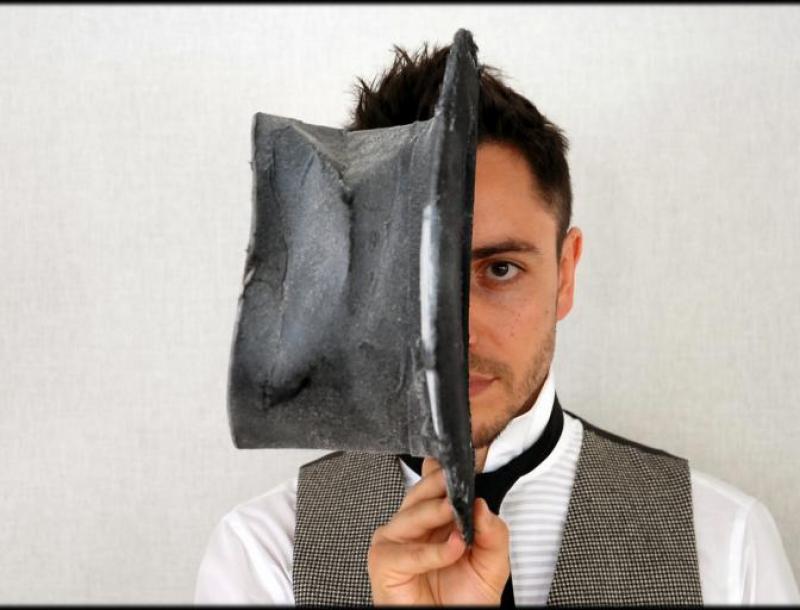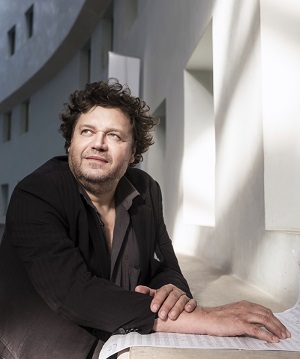Ensemble InterContemporain, Wigmore Hall | reviews, news & interviews
Ensemble InterContemporain, Wigmore Hall
Ensemble InterContemporain, Wigmore Hall
Eccentricity inspires colour, nuance and slapstick from young composer Matteo Franceschini

The Paris-based Ensemble InterContemporain brought a wide-ranging programme to the Wigmore Hall.
Most of the programme was made up of solo or piano-accompanied works, one each for clarinet, viola, violin, and two for flute. Among the soloists, the woodwind sounded more secure than the strings, with clarinettist Jérôme Comte and flautist Sophie Cherrier given many moments to shine. But the unsung hero was pianist Hidéki Nagano, a key ingredient in the programme’s continuity. Nagano has a fluid but definite touch and is able to draw an unusually elegant and warm tone from the Wigmore Steinway. That was immediately evident from the opening notes of the Debussy Première rapsodie, presented here by Nagano and Comte as an essay in colour and atmosphere. Comte began strongly, and although he lost some of his colour when the pace of the runs increased, he was always able to fall back on Nagano.
The Ravel Violin Sonata (now known as No. 2, the programme note reminded us) also benefitted from warm, lyrical accompaniment, but violinist Jeanne-Marie Conquer didn’t have the same presence. She was insecure in the opening and through much of the finale, and the Blues middle movement lacked the necessary swagger. Similarly, violist Odile Auboin was unconvincing in Maderna’s unaccompanied Viola, an open-form work that needs more conviction if it is not to sound merely arbitrary. No such problems, though, from Sophie Cherrier, whose Le Merle noir of Messiaen was the highlight of the first half, the blackbird here roused to colourful and varied song. Her rendition of Berio’s Sequenza I opened the second half, another agile and focused reading – or performance rather, as she played from memory.
 The two modern works were presented as culminations to each half of the concert. Schoeller’s Madrigal is for piano quartet, but neither its instrumentation nor its style give much of a clue as to the choice of title. The composer (pictured left by Franck Ferville) gave a cryptic allusion to the Renaissance vocal form in the programme, saying that his music, like that of the madrigalists, follows "uncountable transformations and pathways that exist between joy and melancholy". That phrase captures the complex but introverted emotional terrain of this music, and also its subtle continuity. We hear complex but subdued tremolo and glissando textures, initially in isolated fragments but soon coalescing into what seem like interconnected movements. An impressive continuity ultimately emerges, but even then it almost seems accidental.
The two modern works were presented as culminations to each half of the concert. Schoeller’s Madrigal is for piano quartet, but neither its instrumentation nor its style give much of a clue as to the choice of title. The composer (pictured left by Franck Ferville) gave a cryptic allusion to the Renaissance vocal form in the programme, saying that his music, like that of the madrigalists, follows "uncountable transformations and pathways that exist between joy and melancholy". That phrase captures the complex but introverted emotional terrain of this music, and also its subtle continuity. We hear complex but subdued tremolo and glissando textures, initially in isolated fragments but soon coalescing into what seem like interconnected movements. An impressive continuity ultimately emerges, but even then it almost seems accidental.
Matteo Franceschini’s work closed the programme, a Wigmore Hall co-commission here receiving its UK premiere. The title is long: ‘Les Excentriques’ Traité physionomique à l’usage des curieux, but is fully justified by the music itself. Franceschini explains that the six substantial movements are portraits of unnamed eccentric characters he has known, exploring the idea of physiological eccentricity from a number of musical angles. The ensemble was made up of every player so far heard: piano quartet plus flute and clarinet, the woodwinds both playing three different sizes of instrument, and the ensemble now conducted – an absolute necessity and done with great skill – by Jens McManama.
Of the six movements, the first and last are fast, while the middle four are slower, though never sedate or laid back. Eccentricity takes the form of disjointed dances in the outer movements, melodic profiles always close to the surface, but the rhythmic foundation fluid and continually morphing from one format to another. Similar ideas are heard in inner movements, a tick-tock obbligato in the violin, for example, remaining steady while all else shifts beneath. The use of the instruments throughout the work is incredibly subtle, even when the results are surreal, even slapstick, and the performance brought out every detail and nuance. Franceschini is clearly a name to watch, and is well deserving of this ensemble’s exemplary advocacy.
rating
Share this article
The future of Arts Journalism
You can stop theartsdesk.com closing!
We urgently need financing to survive. Our fundraising drive has thus far raised £49,000 but we need to reach £100,000 or we will be forced to close. Please contribute here: https://gofund.me/c3f6033d
And if you can forward this information to anyone who might assist, we’d be grateful.

Subscribe to theartsdesk.com
Thank you for continuing to read our work on theartsdesk.com. For unlimited access to every article in its entirety, including our archive of more than 15,000 pieces, we're asking for £5 per month or £40 per year. We feel it's a very good deal, and hope you do too.
To take a subscription now simply click here.
And if you're looking for that extra gift for a friend or family member, why not treat them to a theartsdesk.com gift subscription?
more Classical music
 Scott, Irish Baroque Orchestra, Whelan, RIAM, Dublin review - towards a Mozart masterpiece
Characteristic joy and enlightenment from this team, but a valveless horn brings problems
Scott, Irish Baroque Orchestra, Whelan, RIAM, Dublin review - towards a Mozart masterpiece
Characteristic joy and enlightenment from this team, but a valveless horn brings problems
 Classical CDs: Voice flutes, flugelhorns and froth
Baroque sonatas, English orchestral music and an emotionally-charged vocal recital
Classical CDs: Voice flutes, flugelhorns and froth
Baroque sonatas, English orchestral music and an emotionally-charged vocal recital
 Kanneh-Mason, Britten Sinfonia, Shave, Milton Court - a grin and a big beaming smile
A pair of striking contemporary pieces alongside two old favourites
Kanneh-Mason, Britten Sinfonia, Shave, Milton Court - a grin and a big beaming smile
A pair of striking contemporary pieces alongside two old favourites
 theartsdesk at the New Ross Piano Festival - Finghin Collins’ musical rainbow
From revelatory Bach played with astounding maturity by a 22 year old to four-hand jazz
theartsdesk at the New Ross Piano Festival - Finghin Collins’ musical rainbow
From revelatory Bach played with astounding maturity by a 22 year old to four-hand jazz
 First Person: Manchester Camerata's Head of Artistic Planning Clara Marshall Cawley on questioning the status quo
Five days of free events with all sorts of audiences around Manchester starts tomorrow
First Person: Manchester Camerata's Head of Artistic Planning Clara Marshall Cawley on questioning the status quo
Five days of free events with all sorts of audiences around Manchester starts tomorrow
 Goldscheider, Brother Tree Sound, Kings Place review - music of hope from a young composer
Unusual combination of horn, strings and electronics makes for some intriguing listening
Goldscheider, Brother Tree Sound, Kings Place review - music of hope from a young composer
Unusual combination of horn, strings and electronics makes for some intriguing listening
 theartsdesk Q&A: composer Donghoon Shin on his new concerto for pianist Seong-Jin Cho
Classical music makes its debut at London's K-Music Festival
theartsdesk Q&A: composer Donghoon Shin on his new concerto for pianist Seong-Jin Cho
Classical music makes its debut at London's K-Music Festival
 Helleur-Simcock, Hallé, Wong, Bridgewater Hall, Manchester review - moving lyricism in Elgar’s concerto
Season opener brings lyrical beauty, crisp confidence and a proper Romantic wallow
Helleur-Simcock, Hallé, Wong, Bridgewater Hall, Manchester review - moving lyricism in Elgar’s concerto
Season opener brings lyrical beauty, crisp confidence and a proper Romantic wallow
 Kohout, Spence, Braun, Manchester Camerata, Huth, RNCM, Manchester review - joy, insight, imagination and unanimity
Celebration of the past with stars of the future at the Royal Northern College
Kohout, Spence, Braun, Manchester Camerata, Huth, RNCM, Manchester review - joy, insight, imagination and unanimity
Celebration of the past with stars of the future at the Royal Northern College
 Jansen, LSO, Pappano, Barbican review - profound and bracing emotional workouts
Great soloist, conductor and orchestra take Britten and Shostakovich to the edge
Jansen, LSO, Pappano, Barbican review - profound and bracing emotional workouts
Great soloist, conductor and orchestra take Britten and Shostakovich to the edge

Add comment